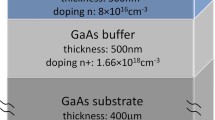Abstract
Hall effect, DLTS and low-temperature photoluminescence measurements were used to study the effect of dimeric (As2) vs tetrameric (As4) vapour species on the electrical and optical properties of nominally undoped and of Ge-doped GaAs layers grown by molecular beam epitaxy (MBE). The arsenic molecular beam was generated from separate As2 and As4 sources, respectively, and from a single source providing an adjustable As2/As4 flux ratio. The occurence of the previously described defect related bound exciton lines in the luminescence spectra at 1.504–1.511 eV was found to be directly correlated with the presence of three deep states (M1, M3, M4) which are characteristic of MBE grown GaAs. The intensity of the extra luminescence lines and simultaneously the concentration of the deep electron traps can be reduced substantially simply by decreasing the As4/As2 flux ratio. The incorporation of defect related centers as well as of amphoteric dopants like Ge strongly depends on the surface chemistry involved. Therefore, a considerably lower autocompensation ratio in Ge-dopedn-GaAs is obtained with As2 molecular beam species which provide a higher steady-state arsenic surface population.
Similar content being viewed by others
References
C.T. Foxon, B.A. Joyce: Surf. Sci.50, 434 (1975)
C.T. Foxon, B.A. Joyce: Surf. Sci.64, 293 (1977)
C.T. Foxon, J.R. Harvey, B.A. Joyce: J. Phys. Chem. Solids34, 1693 (1973)
M.B. Panish: J. Electrochem. Soc.127, 2729 (1980)
A.R. Calawa: Appl. Phys. Lett.38, 701 (1981)
A.Y. Cho, I. Hayashi: Solid State Electron.14, 125 (1971)
J.H. Neave, P. Blood, B.A. Joyce: Appl. Phys. Lett.36, 311 (1980)
H. Künzel, K. Ploog: Appl. Phys. Lett.37, 416 (1980)
K. Ploog: InCrystals, Growth, Properties, and Applications, Vol. 3, ed. by H.C. Freyhardt (Springer, Berlin, Heidelberg, New York 1973)
E.E. Wagner, D. Killer, D.E. Mars: Rev. Sci. Instrum.51, 1205 (1980)
D.V. Lang, A.Y. Cho, A.C. Gossard, M. Ilegems, W. Wiegmann: J. Appl. Phys.47, 2558 (1976)
U. Heim, P. Hiesinger: Phys. Stat. Sol. (b)66, 461 (1974)
G.B. Scott, G. Duggan, P. Dawson, G. Weimann: J. Appl. Phys.52, 6888 (1981)
A.Y. Cho, I. Hayashi: J. Appl. Phys.42, 4422 (1971)
C.E.C. Wood, J. Woodcock, J.J. Harris: Inst. Phys. Conf. Ser. No.45, 28 (1979)
H. Künzel, A. Fischer, K. Ploog: Appl. Phys.22, 23 (1980)
J.H. Neave, B.A. Joyce: J. Cryst. Growth44, 387 (1978)
I. Teramoto: J. Phys. Chem. Solids33, 2089 (1972)
Author information
Authors and Affiliations
Rights and permissions
About this article
Cite this article
Künzel, H., Knecht, J., Jung, H. et al. The effect of arsenic vapour species on electrical and optical properties of GaAs grown by molecular beam epitaxy. Appl. Phys. A 28, 167–173 (1982). https://doi.org/10.1007/BF00617982
Received:
Accepted:
Issue Date:
DOI: https://doi.org/10.1007/BF00617982




